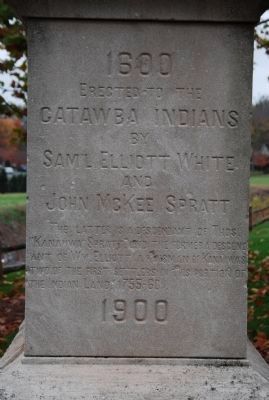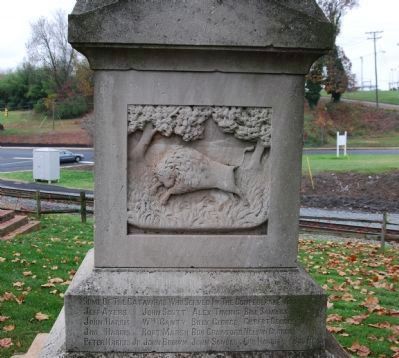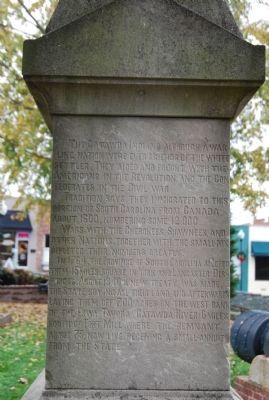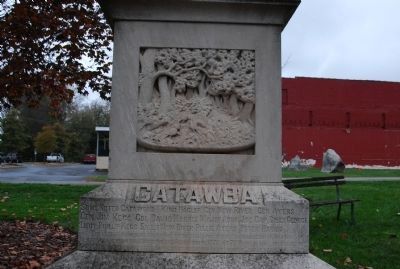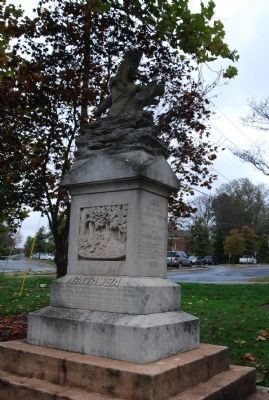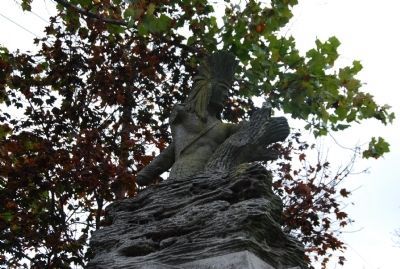Fort Mill in York County, South Carolina — The American South (South Atlantic)
Catawba Indian Memorial
[South Side]:
Erected to the
Catawba Indians
by
Sam'l Elliott White
and
John McKee Spratt
The latter is a descendant Thos. "Kanahwa" Spratt and the former a descendant of Wm. Elliott (a kinsman of Kanahwas) two of the first settlers in this portion of the Indian Land (1755-60).
[East Side]:
Some of the Catawbas who served in the Confederate Army
Jeff Ayers - John Scott - Alex Timins - Bill Sanders - John Harris - Wm Canty - Billy George - Gilbert George - Jim Harris - Robt. Marsh - Bob Crawford - Nelson George - Peter Harris Jr. - John Brown - John Sanders - Epp Harris - Bob Head
[North Side]:
The Catawba Indians although a war-like nation were ever friends of the white settlers. They aided and fought with the Americans in the Revolution and the Confederates in the Civil War.
Tradition says they immigrated to this portion of South Carolina from Canada about 1600, numbering some 12,000.
Wars with the Cherokees, Shawnees, and other nations, together with the small-pox depleted their numbers greatly.
In 1764, the province of South Carolina allotted them 15 miles square in York and Lancaster Districts. About 1840 a new treaty was made, the state buying all their land, and afterwards laying them off 700 acres on the west bank of the Eswa Tavora (Catawba River) 6 miles south of Fort Mill. Where the remnant, about 75, now live receiving a small annuit from the state.
[West Side]:
Some noted Catawbas. King Hagler - Gen. New-River - Gen. Ayers - Gen. Jim Kegg - Col. David Harris - Major John Joe - Cap. Billy George - Lieut. Phillip Kegg - Sallie New-River - Pollie Ayers - Peter Harris
The latter being made an orphan by the small-pox scourge, was raised by Kanahwa. He receives a pension for services in the Revolution of 1776. At 70 years of age, he died at the Saratt Homestead and at his own request was buried in the family graveyard.
Erected 1900 by Sam'l Elliott White and John McKee Spratt.
Topics. This historical marker and memorial is listed in these topic lists: Native Americans • War, US Civil • War, US Revolutionary. A significant historical year for this entry is 1600.
Location. 35° 0.466′ N, 80° 56.685′ W. Marker is in Fort Mill, South Carolina, in York County. Marker is at the intersection of Main Street (State Highway 160) and Academy Street, on the left when traveling east on Main Street. Touch for map. Marker is in this post office area: Fort Mill SC 29715, United States of America. Touch for directions.
Other nearby markers. At least 10 other markers are within walking distance of this marker. To the Faithful Slaves (a few steps from this marker); Fort Mill Confederate Memorial (a few steps from this marker); Women of the Confederacy Memorial (a few steps from this marker); Confederate Park (within shouting distance of this marker); 1LT Elliott White Springs (within shouting distance of this marker); Millstone Park (about 300 feet away, measured in a direct line); Fort Mill (about 400 feet away); Catawba Fort (about 400 feet away); Wilson House (about 400 feet away); Unity Presbyterian Church (approx. 0.4 miles away). Touch for a list and map of all markers in Fort Mill.
Also see . . .
1. Catawba. The Catawba (also known as Issa or Esaw, but most commonly Iswa) are a federally recognized nation of Native Americans, known as the Catawba Indian Nation. (Submitted on January 5, 2010, by Brian Scott of Anderson, South Carolina.)
2. Catawba History. Before contact, the Catawba were probably two separate tribes: the Catawba proper and the Iswa. (Submitted on January 5, 2010, by Brian Scott of Anderson, South Carolina.)
3. Catawba Cultural Preservation Center. Official website of the Catawba Cultural Preservation Center. (Submitted on January 5, 2010, by Brian Scott of Anderson, South Carolina.)
4. King Hagler of the Catawba Indian Nation. King Hagler or Nopkehee (born around 1700) was a chief or King of the Catawba Native American tribe from 1754 to 1763. (Submitted on January 5, 2010, by Brian Scott of Anderson, South Carolina.)
5. General New River. General New River was a Native American leader of the Catawba tribe. (Submitted on January 5, 2010, by Brian Scott of Anderson, South Carolina.)
6. "Catawba Indians Will Be Remembered", The Columbia State, August 1, 1900. For the fourth time in the history of Fort Mill the citizens have assembled for the purpose of unveiling a monument. (Submitted on January 5, 2010, by Brian Scott of Anderson, South Carolina.)
Additional commentary.
1. Catawba Nation History
In 1566, the first contact was made with Europeans.
In 1650, the Catawba and the Iswa united.
The British began to colonize the area that is now South Carolina in the 1670s. The Catawba allied themselves with the new settlers for protection against their traditional enemies – the Cherokee, Iroquois, and Shawnee.
From 1689-1763, the Catawba fought with the British in the French and Indian Wars.
During the 1700s, the Catawba absorbed many smaller tribes, which had been devasted by European diseases and war.
In 1711, they fought with the British against the Tuscarora of North Carolina.
Joined with other native tribes and fought against the colonists during the Yemassee War in 1715.
In 1763, a 15-square-mile South Carolina reservation was established for the Catawba.
Fought with the colonists against the British and Cherokee in the Revolutionary War in 1776.
South Carolina, in 1840, promised the Catawba cash and a new reservation in exchange for the land they occupied. The land was sold but the state did not keep its promises. The Catawba moved briefly to North Carolina. Some joined the Cherokee.
The Catawba returned to South Carolina and purchased 600-plus acres from the state in 1850.
In 1973, the Catawba reorganized and formed a non-profit corporation.
The Catawba were awarded renewed federal recognition in 1993. At this time, they were paid $50 million NOT to reclaim 144,000 acres of their land in York County. (Source: http://www.sciway.net/hist/indians/catawba.html.)
— Submitted January 5, 2010, by Brian Scott of Anderson, South Carolina.
2. Chiefs of the Catawba Tribe
King Yanabe Yalangway (d. 1763) - murdered by a band of Iroquois
King Hagler (Nopkehee) (1750-1763) - murdered by a band of Shawnee
General New River (1763-1801) - chief during much of the Revolutionary War
General Jacob Scott (1801-1821)
General Jacob Ayers (1821-1837) - last chief of the Catawba tribe before South Carolina purchased their lands
General Jim Kegg
— Submitted January 5, 2010, by Brian Scott of Anderson, South Carolina.
3. The Erection of the Catawba Indian Monument
On July 31,1900, the citizens of the nearby town of Fort Mill honored themselves by the erection, with ceremonies, of a monument in honor of the Catawba Indians. On the occasion Ben Harris (the tribe have adopted Christian names) spoke with rude pathos, in broken English, as follows:
"Love prompted White and Spratt to build monument. Much thank them good men. Indian love them. Glad Indian now getting education. Fifty years from now, if wanted, Catawba he make good speech as white man. Much thank to people for love shown. My forefathers show love by fighting and give life. I show love try to make a speech. All Indians grateful." (Source: Historic Camden, Volume 2 by Thomas J. Kirkland and Robert Macmillan Kennedy (1905), pg 59.)
— Submitted January 5, 2010, by Brian Scott of Anderson, South Carolina.
4. Catawba Indian Monument
Samuel Elliott White purchased and unveiled this monument on May 10, 1900. John McKee Spratt, who was preparing to join the Confederacy army at age sixteen when the Confederacy collapsed, helped White with the purchase. Spratt, the great grandson of "Old Kanahwa," had interests in farming, lumber, fertilizer, and the cotton mill in Fort Mill after the war.
The monument commemorates the bravery of the Catawba Indians who served in the Confederate army and lists the names of seventeen of them. Originally, the monument held the statue of a Catawba brave holding a bow and arrow as if stalking game. Over half a century ago, a storm blew down a large oak branch, which served both of the brave's arms and the bow and arrow. The damage was never repaired. (Source: A Guide to Confederate Monuments in South Carolina: "Passing the Silent Cup" by Robert S. Seigler (1997), pgs 340-341.)
— Submitted January 6, 2010, by Brian Scott of Anderson, South Carolina.
5. Before it was damaged
Does anyone have a photo of the monument before the tree limb fell? The Children of the Confederarcy in SC had wanted to see if it could be repaired and wanted to take this on as a project. I have spoken with the Reservation and they do not have a copy of the original. Have reseached newspapers and there is no photo. Surely there must be one somewhere.
Editor's Note: Can anyone assist the Children of the Confederarcy in SC with their search for a photograph of the memorial before it was damaged?
— Submitted July 12, 2010, by Theresa Pittman of Clarks Hill, South Carolina.
Credits. This page was last revised on February 26, 2022. It was originally submitted on November 25, 2009, by Michael Sean Nix of Spartanburg, South Carolina. This page has been viewed 5,335 times since then and 163 times this year. Photos: 1, 2, 3, 4, 5, 6. submitted on November 25, 2009, by Michael Sean Nix of Spartanburg, South Carolina. • Craig Swain was the editor who published this page.
